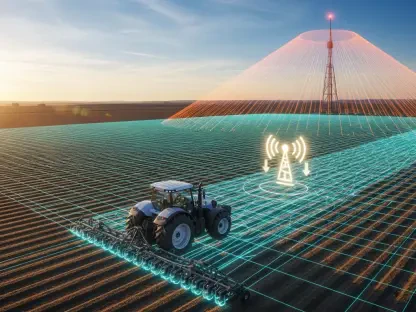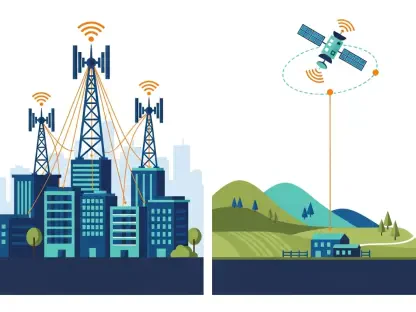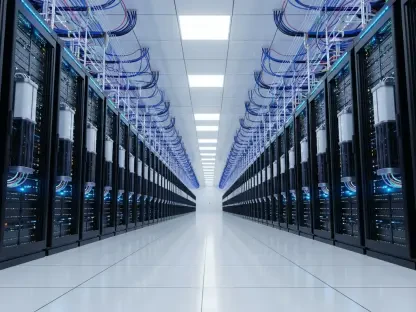In an era defined by rapid technological advancements and ever-evolving industry standards, enterprise networks are undergoing significant transformation as businesses strive to keep pace with emerging trends and challenges reshaping network strategies. As these digital ecosystems evolve, network teams are increasingly leveraging artificial intelligence (AI) alongside a convergence of network operations (NetOps) and security operations (SecOps) to enhance the efficiency, security, and visibility of enterprise networks. This move reflects a broader industry trend toward more integrated operations, necessitating innovative approaches to network management.
Evolving Monitoring Strategies
Fragmented Tool Landscape
The findings reveal a complex and fragmented landscape across the tools used by organizations to monitor their networks. Network performance monitoring technologies dominate, embraced by over 80% of respondents. Meanwhile, application performance management and digital experience monitoring technologies are utilized by more than 60% of respondents, and security information and event management (SIEM) tools as well as infrastructure monitoring systems find favor with over 70%. A significant subset of the respondents, approximately a quarter, reported using the full spectrum of monitoring tools available to them, indicating a varied approach to addressing diverse network challenges.
Despite the proliferation of monitoring tools, businesses face the challenge of integrating these distinct technologies within their existing frameworks. This fragmented environment complicates the task of obtaining a cohesive view of network health and performance. While network teams are striving to streamline operations, they often encounter hurdles in bridging the gap between complex and overlapping toolsets. The drive for consolidation is met with resistance as businesses seek to balance the need for comprehensive monitoring with the practicalities of deployment, utilization, and maintenance of multifaceted monitoring solutions.
Transition to Hybrid Deployment Models
The deployment models of monitoring tools in enterprise systems predominantly feature a hybrid approach, reflecting the multifaceted needs of modern organizations. Approximately 63% of respondents have adopted a platform-based system with supplemental tools, allowing businesses to tailor solutions to specific operational demands. Yet, this hybrid model is not static; transitional dynamics indicate a shift as organizations express aspirations to diverge from the hybrid approach. Preferences vary, with some businesses eyeing multi-vendor monitoring frameworks integrated through purpose-built architectures, while others favor single-vendor solutions to reduce complexity.
Nevertheless, such aspirations often clash with reality, as demonstrated by a recorded increase in hybrid deployments in recent surveys. Many organizations find themselves constrained by existing systems and operational inertia. Despite a stated preference for moving away from hybrid architectures, the practicality and immediate benefits of these setups continue to resonate with businesses. This reflects the dynamic tensions faced by network teams as they navigate between their strategic goals and the operational demands of maintaining a robust and adaptive monitoring framework in a rapidly evolving technological environment.
NetOps/SecOps Convergence
Industry Trends towards Integrated Operations
The convergence of Network Operations (NetOps) and Security Operations (SecOps) stands out as a pivotal point in current enterprise network trends. This integration represents an evolution from traditional, siloed operations to a unified framework where network management and security are intrinsically linked. Chris Labac of Viavi highlights that these shifts aim to foster collaboration, harnessing collective toolsets to address multifaceted challenges. Despite 79% of survey respondents acknowledging a trend towards integrated operations, actual realization remains limited, hinting at an industry still grappling with this paradigm shift.
Interdepartmental cooperation plays a crucial role in achieving this convergence, requiring common data sources and synchronized processes to effectively reduce departmental conflicts. However, organizations face challenges in aligning technology and human resources to create cohesive operational strategies. As network tools and security measures increasingly overlap, developing a harmonious relationship between NetOps and SecOps teams becomes vital. This shift toward integrated operations is not merely a technological change but a cultural one, demanding adaptation, innovation, and a commitment to overcoming traditional operational barriers.
Barriers and Aspirations for True Convergence
While the aspiration for convergence is evident, significant barriers persist, leading to a notable disconnect between NetOps and SecOps teams within many organizations. These barriers include legacy systems, lack of standardized processes, and disparate toolsets that impede seamless cooperation. The report identifies common data platforms as a vital step toward bridging operational divides, yet their implementation often lags behind organizational aspirations. Overcoming these challenges involves a concerted effort to harmonize processes and technology, enabling teams to collaboratively respond to the complexities of modern network management.
Aligning the aspirations for true convergence with actionable strategies necessitates a commitment to evolving both technological paradigms and internal processes. Organizations must prioritize investments in cross-functional training, integrated data sources, and cohesive infrastructure to unlock the potential of this convergence. As NetOps and SecOps roles continue to blur, embracing an all-encompassing approach will facilitate the creation of resilient and adaptive networks. Ultimately, achieving true convergence will require both technological advancements and a cultural shift that emphasizes the interconnectedness of security and performance within enterprise networks.
Packet Capture’s Enduring Role
Importance of Packet Capture
In the evolving landscape of network management, the role of packet capture remains vital, offering concrete data that significantly enhances visibility across enterprise infrastructures. The technology, long embedded within industry practices, provides essential insights by capturing and analyzing network traffic in real time. This capability is crucial for identifying and resolving network issues efficiently, often resulting in reduced mean-time-to-resolution (MTTR) and subsequently improving operational performance and reliability. For businesses prioritizing network reliability, robust packet capture strategies emerge as indispensable.
Crucially, packet capture serves as a backbone for a wide range of network visibility and security operations. Its continued relevance in enterprise networks underscores its adaptability, offering comprehensive insights into network behavior over time. This foundational role is indispensable in scenarios where rapid identification and resolution of anomalies are paramount. By enabling detailed forensic analysis of network events, packet capture technology equips organizations with the tools needed to safeguard their networks proactively, ensuring that every packet of data is accounted for and analyzed for potential threats or irregularities.
Challenges and Advantages in Cloud Environments
As enterprises navigate the complexities of cloud environments, the implementation of packet capture presents unique challenges and opportunities. Viavi’s observation reveals a discrepancy in how leadership and operational staff perceive its value, with executives more often appreciating its strategic benefits. Cloud environments demand specialized expertise for implementing effective packet capture, contrasting with the straightforward deployment within traditional network infrastructures. Despite these challenges, businesses are recognizing the integral role packet capture plays, particularly in harmonizing NetOps and SecOps efforts.
In cloud settings, native tools often lack the depth needed, making third-party solutions a valuable resource. These solutions are designed explicitly for capturing and analyzing packet data, fostering a more comprehensive understanding of network dynamics within cloud architectures. By enhancing cloud visibility through detailed packet analysis, businesses can adapt to changing demands, ensuring seamless operations. Moreover, integrating packet capture in cloud frameworks enhances security by providing essential forensic capabilities, critical for investigating and mitigating potential threats across hybrid and dynamic cloud environments.
AI’s Transformative Impact
AI Integration in Enterprise Networks
The integration of artificial intelligence into enterprise networks marks a transformative phase for network management, positioning AI as a pivotal factor in enhancing efficiency and operational capabilities. As organizations explore AI’s potential, vendors face mounting pressure to develop robust AI integration strategies tailored to diverse network environments. The survey identifies AI as a game-changer, with companies keen on evaluating its potential for enhancing existing toolsets and operational processes, steadily pushing vendors to innovate and meet this burgeoning demand.
AI offers transformative capabilities by automating complex network tasks and delivering predictive insights, acting as an enabler of smarter network solutions. By leveraging AI-driven insights, network teams can gain a deeper understanding of network behavior, preemptively address anomalies, and optimize network performance. These advancements are gradually cultivating an environment where AI’s role in analyzing packet and flow data becomes increasingly indispensable. As AI tools continue to mature and evolve, they promise to redefine network operations, shaping the future of enterprise network management.
Future Prospects of AI in Networking
Looking ahead, the potential of AI in transforming networking remains vast, with its evolution anticipated to bring about increased synergy between existing workflows and advanced analytical capabilities. Organizations are already employing AI algorithms and machine learning techniques to gain insights into end-user experiences and diagnose the root causes of network issues. Viavi envisions future developments where natural language processing (NLP) plays a critical role in expanding these capabilities. By integrating NLP interfaces, AI systems can interact with teams through natural language queries, streamlining diagnostic processes and enriching user interactions.
The incremental extension of AI capabilities holds promise for a more intuitive approach to network management, enabling faster, data-driven decisions and fostering an environment conducive to proactive network strategies. As AI technology advances, its integration into enterprise networks is expected to become more seamless, creating opportunities for improved decision-making and performance optimization—ushering in a new era of intelligent networking solutions. The ongoing pursuit of AI integration represents a critical step towards achieving highly responsive and adaptive network management frameworks essential for modern enterprises.
Navigating Emerging Network Frontiers
In today’s world, marked by swift technological growth and continuously changing industry norms, enterprise networks are experiencing profound transformations as companies aim to adapt to the latest trends and challenges that are altering network strategies. Within these digital frameworks, network teams are increasingly turning to artificial intelligence (AI), alongside a merging of network operations (NetOps) and security operations (SecOps), to improve the efficiency, security, and transparency of enterprise networks. This shift emphasizes a broader industry movement towards more unified operations, which demands novel approaches to network management. The integration of AI and operational convergence presents opportunities to revolutionize how networks are managed, allowing for enhanced responsiveness and adaptability in addressing complex needs. As businesses navigate this dynamic landscape, they’re striving for network ecosystems that can seamlessly support growth while ensuring robust security protocols, fostering a future-ready network environment.









